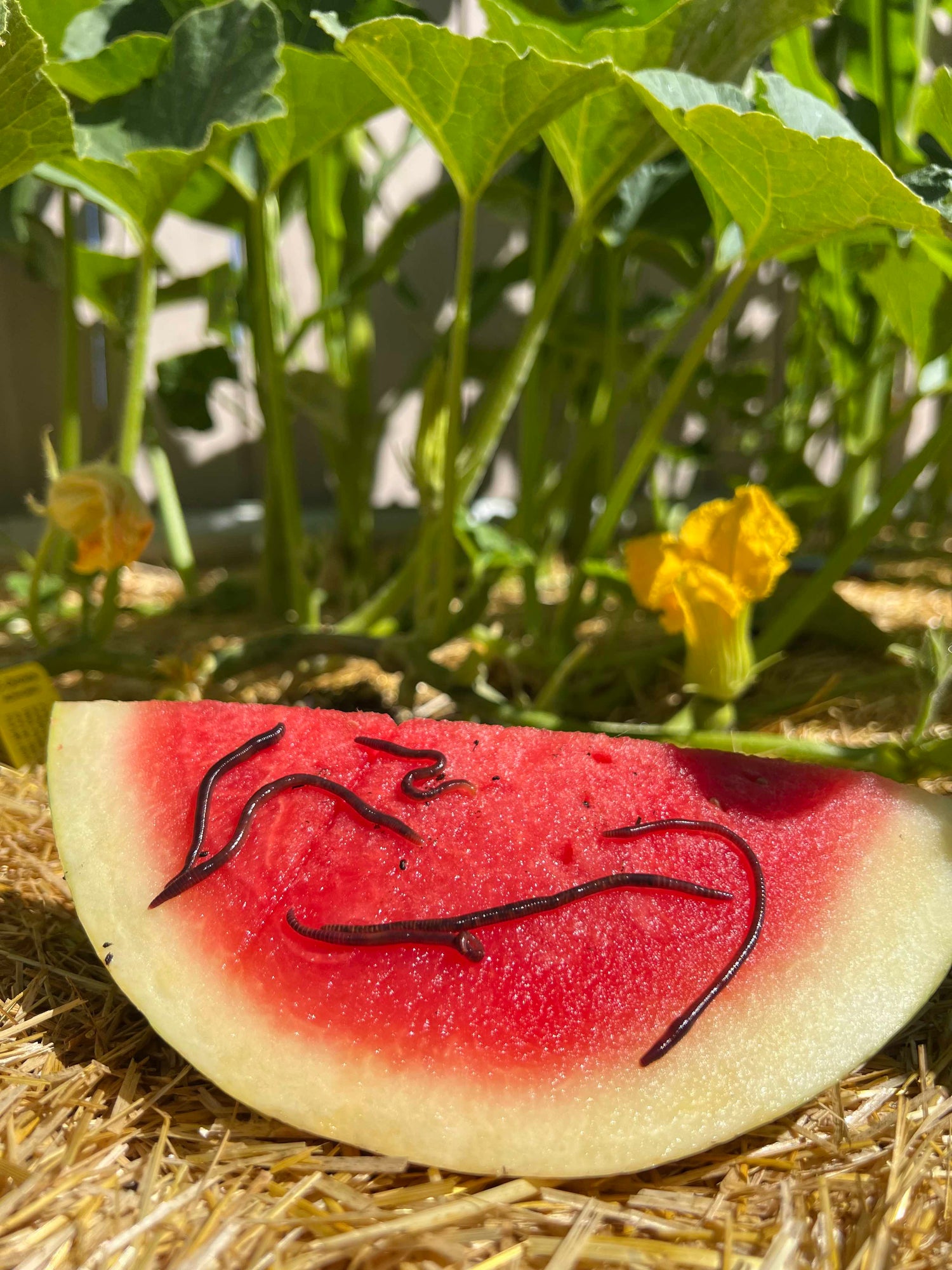Nightcrawlers vs Red Wigglers, When it comes to organic gardening, worms take center stage as the ultimate soil superheroes. But which worm reigns supreme in the battle of Nightcrawlers versus Red Wigglers? In this showdown, we dive deep into the world of these two remarkable creatures, examining their characteristics, strengths, and how they contribute to your garden's success. Nightcrawlers, with their impressive size and deep-dwelling abilities, are known for their exceptional burrowing skills and a preference for organic material. On the other hand, Red Wigglers, also called composting worms, are renowned for their voracious appetites for kitchen scraps and their rapid reproduction rates. Join us as we explore the benefits and differences between these two worm powerhouses. Discover which worm is the best fit for your organic gardening goals and why they hold the key to creating fertile and nutrient-rich soils that will promote healthy plant growth. Whether you're a gardening enthusiast or new to the worm-filled world of organic gardening, this showdown will equip you with the knowledge you need to make an informed decision. Get ready to choose your champion and unlock the secrets of successful organic gardening!
Table of content
Introduction into Nightcrawlers vs Red Wigglers
When it comes to organic gardening, worms take center stage as the ultimate soil superheroes. But which worm reigns supreme in the battle of Nightcrawlers versus Red Wigglers? In this showdown, we dive deep into the world of these two remarkable creatures, examining their characteristics, strengths, and how they contribute to your garden's success.
Nightcrawlers, with their impressive size and deep-dwelling abilities, are known for their exceptional burrowing skills and a preference for organic material. On the other hand, Red Wigglers, also called composting worms, are renowned for their voracious appetites for kitchen scraps and their rapid reproduction rates.
Join us as we explore the benefits and differences between these two worm powerhouses. Discover which worm is the best fit for your organic gardening goals and why they hold the key to creating fertile and nutrient-rich soils that will promote healthy plant growth.
Whether you're a gardening enthusiast or new to the worm-filled world of organic gardening, this showdown will equip you with the knowledge you need to make an informed decision. Get ready to choose your champion and unlock the secrets of successful organic gardening!
The Importance of Worms in Organic Gardening
Worms play a crucial role in organic gardening by improving soil structure, nutrient availability, and overall plant health. They are nature's ultimate recyclers, breaking down organic matter and transforming it into nutrient-rich castings that plants can readily absorb. Their burrowing activities also enhance soil aeration and drainage, creating a favorable environment for plant root growth. Let's delve into the world of nightcrawlers and red wigglers to understand how they contribute to the success of organic gardening.
Overview of Nightcrawlers
Nightcrawlers, also known as Lumbricus terrestris, are the giants of the worm world. They can grow up to 14 inches long and are most active during the night, hence their name. Nightcrawlers are burrowing worms that prefer to dwell deep in the soil, making vertical burrows that can extend several feet. These burrows help in soil aeration and the penetration of roots, allowing plants to access water and nutrients more efficiently.
One of the notable characteristics of nightcrawlers is their ability to consume large amounts of organic material. They have a voracious appetite and can process dead leaves, decaying wood, and other organic matter, breaking it down into nutrient-rich castings. Nightcrawler castings are packed with essential nutrients like nitrogen, phosphorus, and potassium, making them a valuable addition to garden soils.
In addition to their impressive burrowing abilities and nutrient-rich castings, nightcrawlers also play a role in soil structure improvement. Their burrows create channels that improve water infiltration and drainage, preventing soil compaction and waterlogging. These tunnels also allow plant roots to penetrate deep into the soil, accessing water and nutrients from lower layers.
Considering their large size and deep-dwelling nature, nightcrawlers are well-suited for larger-scale gardens or areas with heavy clay soils that benefit from improved drainage and aeration. However, they may not be the best fit for smaller gardens or container gardening due to their preference for deep burrowing.
Overview of Red Wigglers
Red wigglers, scientifically known as Eisenia fetida, are the composting champions of the worm world. These smaller worms typically reach lengths of 2-3 inches and are reddish-brown in color. Red wigglers are surface-dwelling worms that prefer to live in the top layers of organic material, such as compost or worm bins.
One of the distinct characteristics of red wigglers is their rapid reproduction rate. A healthy population of red wigglers can double in size every 2-3 months, making them excellent composting partners. Their voracious appetite for kitchen scraps, vegetable peelings, coffee grounds, and other organic waste makes them ideal for vermicomposting. Red wigglers efficiently break down organic matter, converting it into nutrient-rich castings that can be used as a natural fertilizer.
Apart from their composting abilities, red wigglers also contribute to soil health. Their castings are rich in beneficial microorganisms that help suppress harmful pathogens and enhance plant growth. Red wigglers improve soil structure by creating tunnels close to the surface, facilitating water infiltration and root development.
Red wigglers are a great choice for small-scale gardens, balconies, or indoor gardening due to their compact size and ability to thrive in confined spaces. Their quick reproduction rate ensures a steady supply of compost for your plants, making them an excellent choice for those with limited space or those looking to reduce food waste.
Comparing Nightcrawlers and Red Wigglers in Terms of Composting
Both nightcrawlers and red wigglers excel at composting, but they differ in their preferences and capabilities. Nightcrawlers are better suited for composting larger organic materials, such as dead leaves, twigs, and yard waste. Their large size and powerful digestive system allow them to process bulky materials efficiently. However, they are not as effective at processing kitchen scraps or finer organic matter.
On the other hand, red wigglers are composting specialists when it comes to kitchen scraps and finer organic waste. Their smaller size and voracious appetite make them perfect for breaking down fruit and vegetable peels, coffee grounds, tea bags, and other similar materials. Red wigglers can consume their own body weight in organic matter daily, ensuring rapid decomposition and nutrient release.
When choosing between nightcrawlers and red wigglers for composting, consider the type and quantity of organic waste you generate. If you have a large amount of yard waste and prefer composting on a larger scale, nightcrawlers are the better choice. However, if you primarily generate kitchen scraps and have limited space, red wigglers are the ideal composting companions.
Comparing Nightcrawlers and Red Wigglers in Terms of Soil Aeration
Soil aeration is crucial for healthy plant growth, as it allows roots to access oxygen and nutrients. Both nightcrawlers and red wigglers contribute to soil aeration, but their methods differ. Nightcrawlers create deep burrows that improve water drainage and root penetration in heavy soils. Their burrows act as channels for air movement, preventing soil compaction and promoting a healthy soil environment.
Red wigglers, on the other hand, create tunnels closer to the soil surface. These tunnels enhance surface aeration and allow for the exchange of gases between the soil and the atmosphere. While not as effective at deep soil aeration as nightcrawlers, red wigglers still play a vital role in maintaining soil health and promoting root development.
The choice between nightcrawlers and red wigglers for soil aeration depends on your specific gardening needs. If you have heavy clay soils or areas prone to compaction, nightcrawlers can help improve soil structure and drainage. If you have lighter soils or are primarily concerned with surface aeration, red wigglers are a suitable choice.
Choosing the Best Worm for Your Organic Garden
Now that we've explored the characteristics and benefits of nightcrawlers and red wigglers, it's time to choose the best worm for your organic garden. Consider the following factors when making your decision:
1. **Garden Size:** Nightcrawlers are better suited for larger gardens or areas with heavy clay soils that benefit from improved drainage and aeration. Red wigglers are ideal for smaller gardens, balconies, or indoor gardening due to their compact size and ability to thrive in confined spaces.
2. **Composting Needs:** If you generate a large amount of yard waste and prefer composting on a larger scale, nightcrawlers are the better choice. If you primarily generate kitchen scraps and have limited space, red wigglers are the ideal composting companions.
3. **Soil Conditions:** If you have heavy clay soils or areas prone to compaction, nightcrawlers can help improve soil structure and drainage. If you have lighter soils or are primarily concerned with surface aeration, red wigglers are a suitable choice.
Consider your gardening goals, available space, and specific needs to determine whether nightcrawlers or red wigglers are the best fit for your organic garden. Remember, both worms contribute to soil health and plant growth in their unique ways.
Conclusion and Final Thoughts: Nightcrawlers vs Red Wigglers
In the showdown between nightcrawlers and red wigglers, there is no clear winner. Both worms have their strengths and benefits, making them valuable allies in organic gardening. Nightcrawlers excel in deep soil aeration, processing larger organic materials, and improving soil structure. Red wigglers shine in composting kitchen scraps, rapid reproduction, and surface aeration.
The best approach is to consider your specific gardening needs, available space, and composting preferences. You may even choose to have both nightcrawlers and red wigglers in your garden, capitalizing on their individual strengths. By harnessing the power of these soil superheroes, you can create fertile and nutrient-rich soils that promote healthy plant growth.
Whether you're a beginner or a seasoned gardener, embracing the world of worms will unlock the secrets of successful organic gardening. So choose your champion, either nightcrawlers or red wigglers, and let these remarkable creatures work their magic in your garden. Get ready to witness the wonders of nature and experience the joy of growing your own organic oasis!





Leave a comment
All comments are moderated before being published.
This site is protected by reCAPTCHA and the Google Privacy Policy and Terms of Service apply.